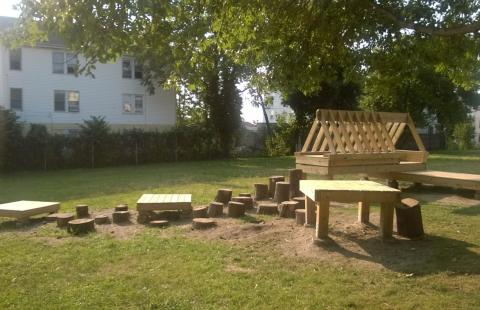What were the specific goals of this creative economy project? Describe the community development challenge or opportunity that your project was designed to address:
A major goal of the Providence Parks Project was to help advance neighborhood revitalization efforts and improve health outcomes by creating spaces for active outdoor play in these neighborhoods. According to Ellen Cynar of the Healthy Communities Office, “the City of Providence’s extremely high chronic disease burden, along with significant racial, ethnic and socioeconomic disparities, predispose Providence youth to an increased risk of premature death, reduced quality of life and very high medical costs.” According to the RI Youth Risk Behavior Survey, 38% of Hispanic and 32% of Black teens (most of whom reside in Providence) are overweight or obese compared to 24% of non-Hispanic White teens. The RI Dept of Health finds that over 60% of Black adults and youth in RI are less physically active than the recommended minutes per week; 43% of non-Hispanic Black and 38% of Hispanic youth watch more than 3 hours of TV per day. In the South Side and West End (the lowest-income Providence neighborhoods), hypertension, obesity and diabetes are priority focus areas; 34% of adults in these areas have high blood pressure and 11% have diabetes.
The public parks selected for this project had seen an increase in negative uses like gang activity, drug use and violence. In addition to promoting exercise and outdoor play, our goal was to create more opportunities for positive use of the space by children and their families, in order to shift the dynamic within these neighborhoods and promote safety and community.
If the goals change over time, please describe how:
Initially, we imagined that fostering Healthy Communities through projects in our parks would encompass youth and adult activities. In addition to play structures, we imagined information kiosks, exercise tracks, and social gathering spots for all ages. As our students interviewed neighborhood residents and Parks Dept officials, though, they decided they wanted to focus their efforts on creating projects for young children. Their hope was that by enticing youth to the parks, they would help create healthy, active young people who would be life-long supporters of the parks.
Who was involved in this project and what did they do? (be sure to include the partners from outside of the creative sector and how local voices were included):
Our major partner in this project was the Providence Department of Parks and Recreation. Wendy Nilsson, Superintendent of Parks, and Deputy Superintendent Brian Byrne, saw the potential of this initiative to model change from within a community. They were excited by the potential of this effort to empower young people to become change-makers, and stewards of public parks. They shared a list of public parks in need of attention and improvement, and assisted with selection of our sites. In the early stages of the process, our young designers interviewed them to learn more about their approach to creative placemaking within our parks, and the needs of these particular parks. Brian Byrne, a licensed Playground Safety Inspector, shared relevant building code with our teen designers, and reviewed their plans several times to provide feedback and ensure that the structures would be structurally sound and safe. We also partnered with the Providence Office of Healthy Communities, and the Partnership for Providence Parks, who assisted us by providing data on park usage and helped to rally volunteers to assist with project completion.
How does this project relate to a larger community development strategy?
The City of Providence recognizes the value of our city's green spaces as places of respite, community gathering, exercise, and play. The mayor's office has created several new programs aimed at activating and programming these spaces, along with our community rec center facilities. The Providence Parks Department is under-resourced, and have been developing new strategies to work creatively with limited resources. They achieve this through creative partnerships and volunteer Friends groups, and they saw these projects as an opportunity to build ownership of the selected park sites within their neighborhoods and generate long-term stewardship. They are also working hard to use fewer "off-the-shelf" plastic play structures, which are expensive, difficult to maintain, and not environmentally friendly. The Parks Department appreciated DownCity Design's use of natural and reclaimed materials wherever possible, in order to work toward a more sustainable future for our parks.
